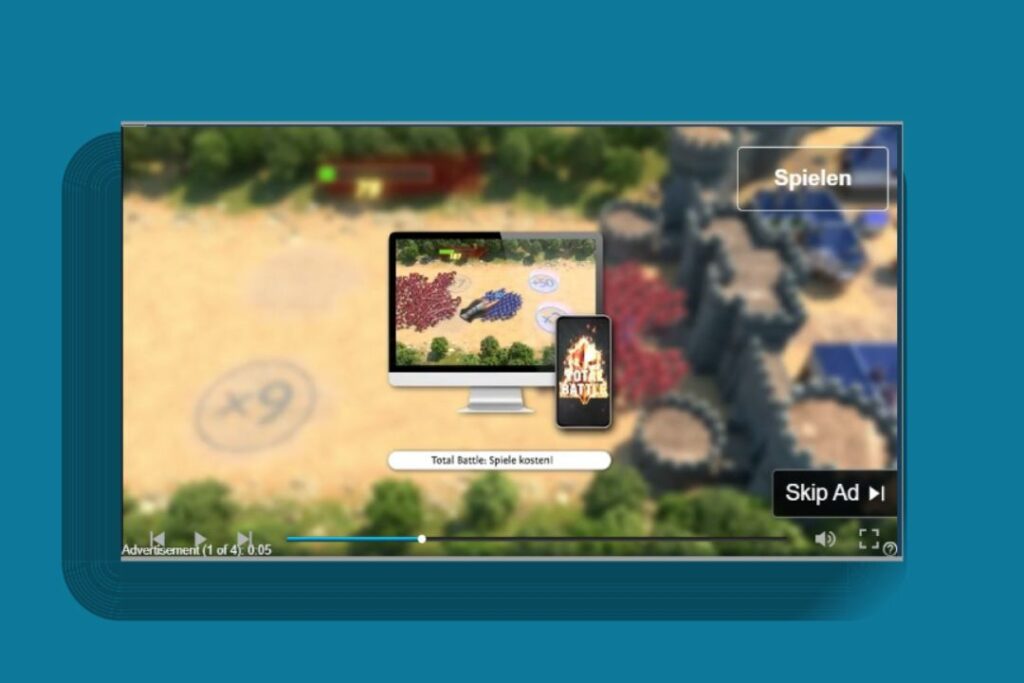
What are instream and outstream video ads exactly?
Instream and outstream ads are two types of video ads. Instream ads are the ones that are played before, during, or after the main video content on a website. Outstream ads are the ones that are not played directly on the website but on a network of websites that the advertiser has partnered with. Both instream and outstream ads have their pros and cons. We will analyze both ad types in detail to give you a understanding of which ad unit suits best for your website/app or marketing purposes.
What are instream ads?
Instream video ads are a type of video advertising that appear between content on websites, apps, and social media platforms such as Facebook, TikTok, Instagram, as well as video platforms such as YouTube, Vimeo, Daily Motion. Unlike outstream video ads, which are mostly skippable after a 4-6 seconds, instream video ads must be watched before the user can continue to view the content. Instream video ads come in a variety of formats, including pre-roll (before the video content), mid-roll (during the video content), and post-roll (after the video content). Depending on the platform, they can also be skippable or non-skippable.

Instream video ads are an effective way to reach a wide audience with your message. They can be used to promote your brand, product, or service, and can be customized to target specific demographics.
As a website publisher, you’re always looking for new ways to monetize your site and generate revenue. Instream and outstream ads are both good ways to monetize your website. And, in today’s digital world, video advertising is the most effective way to do just that.
Instream video ads are a type of video advertising that appear before during or after video content on websites, apps, and social media platforms. Instream video ads come in a variety of formats, including pre-roll (before the video content), mid-roll (during the video content), and post-roll (after the video content). Depending on the platform, they can also be skippable or non-skippable.
Instream video ads are an effective way to reach a wide audience with your message. They can be used to promote your brand, product, or service, and can be customized to target specific demographics.
When it comes to website monetization, instream video ads are a great option. They’re easy to implement, and can be highly effective in generating revenue. So, if you’re looking for a new way to monetize your website, consider using instream video ads.
A well configured instream video ad unit may bring 2-13x revenue of any display banner.
Pros of instream ads
Instream video advertising has many benefits that website publishers can take advantage of. These benefits include:
- Increasing website revenue more than any other ads: Instream video advertising can help website publishers increase their website revenue. This is because video ads tend to have high CPMs, click-through rates and can be very effective in increasing website revenue: refer to our guide on how to increase digital display ads performance.
- Multiply your inventory: Instream ads can have more than 100% fill rate and websites/apps can double or even triple their inventory.
- Improving website user experience: Instream video advertising can also help improve the user experience on a website. This is because video ads can be used to improve the content on a website and make it more engaging for users.
- Not intrusive: The main benefit of instream video ads is that they are a relatively unobtrusive way to monetize content. Website visitors are typically used to seeing ads on websites, and so instream video ads are unlikely to cause much annoyance or disruption.
There are several benefits of using instream video ads for the advertisers, including the ability to target a specific audience, the ability to track user engagement, and the ability to generate income from advertisements.
According to Google, the benefits of instream ads for advertisers are:
- Drive conversions, influence consideration, and reach new users across multiple devices with your ads, including desktop computers, phones, and TVs.
- Bid for what you care about. Depending on your campaign goal, you can pay based on overall impressions, or when viewers watch your ad completely or interact with the video (whichever comes first).
- Add interactive features like call-to-action buttons, sitelink assets, product feeds, and more to your ads to encourage people to interact with your brand or business more.
Cons of instream ads
There are also some negatives that website publishers need to be aware of when using instream video advertising. These negatives include:
- Potential for high costs: Another potential negative of using instream video advertising is that it can sometimes be expensive. This is because video ads can be costly to produce and to host. As CineWeb, we handle the costs of hosting and serving videos and video ads.
- May affect user experience: Instream video ads can have a negative impact on the quality of the video content if they are unskippable. When they’re often unskippable, they can force users to watch low-quality, pre-roll ads. We use top quality ad demand and provide highly related ads by precision targeting and semantic analysis of the video and the text contents for our instream ads.
What are outstream ads?
Outstream video ads are a new and exciting way for website publishers to monetize their content. By placing these ads in strategic locations on their site, publishers can maximize their earnings potential without having to sacrifice the quality of their content.
So, what exactly are outstream video ads? Outstream video ads are basically video ads that are played outside of the traditional video player environment. In other words, they can be placed anywhere on a website, as long as there is enough space for them to load and play properly.

This new format of video advertising has already proven to be quite popular among website publishers, as it offers a great way to monetize their content without interrupting the user experience. If you’re a website publisher looking to maximize your earnings potential, outstream video ads are worth considering in certain cases where publisher cannot use a floating in-read content player above the fold.
Pros of outstream ads
Outstream video ads are a type of video advertising that allows website publishers to monetize their content with video ads that may or may not be interruptive.
Benefits:
- No content needed: Outstream video ads are also a great way to reach a wider audience as they can be placed on websites that don’t have a lot of video content.
- Flexible: Outstream video ads are flexible in that they can be placed almost anywhere on a website or within content.
- Effective: Outstream video ads are an effective way to monetize content as they are not easily ignored by users.
Cons of outstream Ads
Here are the disadvantages of outstream ads for website/app publishers:
- Potentially intrusive: Some users may find outstream video ads to be intrusive, especially if they are not relevant to the content they are consuming.
- Can be disruptive: If not placed properly, outstream video ads can disrupt the user’s experience.
- Low revenue: Outstream video ads create lower revenue compared to floating instream video ads.
The differences between instream and outstream ads, and which one is right for your business?
If you are an advertiser, instream ads will work much better for return on ad spend (ROAS) purpose than outstream ads. According to the research of Wyzowl, “88% of people said they would like to see more video from brands in 2022. And 73% of people said that a short video is their favorite way to learn about a product or service.”
As a website publisher and if your goal is to generate revenue, then instream ads are typically the better option. That’s because they have a higher CPM (cost per thousand impressions) than outstream ads. In other words, you’ll make more money per view with instream ads.
However, if your goal is to maximize ad fill rate (the percentage of ad impressions that are actually served), then both instream and outstream ads can be typically good options depending on how to setup instream ad units. When the instream ad unit starts in the content and floats (or becomes sticky) after scrolling, then it is the highest fill rate generating setup.
Ultimately, the decision of which one to use comes down to your specific goals and needs. If you don’t have a good banner space for instream or in-read ads, then outstream ads may be a wiser choice. If you’re not sure which one is right for you, experiment with both and see which one performs better.
Conclusion
Instream and outstream ads are great ways to monetize your website inventory. Instream video advertising is typically the better option for website publishers looking to generate revenue. This is because instream ads have a higher CPM (cost per thousand impressions) than outstream ads. Instream ad units will have high fill rates when they are configured to float and get a sticky position after scrolling the webpage. In other words, you’ll make more money per view with instream ads. If your goal is to maximize ad fill rate (the percentage of ad impressions that are actually served), then both instream and outstream ads can be typically good options depending on how to setup instream ad units.
We hope this quick overview has given you a better understanding of instream and outstream video ads and how they can benefit you as a website publisher. If you have any questions, feel free to reach out to us and we’ll be happy to help. CineWeb instream ad units have open market demand plus direct deals from top global companies to ensure you get the maximum revenue without need to sell your inventory directly.
If you are looking for the meanings and explanations of digital advertising terms, you can check our digital advertising glossary.
FAQ
Instream ads are video ads that are played before, during, or after the main video content on a website or app. Outstream ads are video ads that are played in places where there is no video content, such as in between paragraphs of text.
Instream and outstream ads are effective because they are highly visible and can capture the attention of viewers. They can also be interactive, which makes them more engaging and memorable.
Instream and outstream ads can improve brand awareness, reach a wide audience, and generate leads. They can also be used to drive traffic to a website or landing page.
Some tips for creating an effective instream or outstream ad include: using high-quality video, using persuasive and attention-grabbing copy, and targeting your ad to the right audience.
Some common mistakes to avoid when creating instream and outstream ads include: using low-quality video, using boring or uninteresting copy, and not targeting your ad to the right audience.
Instream video ads can appear on websites, apps, and social media platforms that host video content.
Outstream video ads work by playing a video ad code on a website. The outstream ads don’t have content. They appear only when there is an ad. The video ad is usually placed on the website’s homepage or on a specific page that the website owner has chosen.
We can provide content for free. You don’t need to have content.
There are a few different ways that you can monetize your website with video ads. One way is to work with a video ad network such as CineWeb Media. We collected all open market SSP and DSP and combined it with direct deald from top global brands in order to achieve the maximum results.
Another way to monetize your website with video ads is to work directly with advertisers. You can reach out to companies that you think would be a good fit for your website and see if they are interested in placing an ad. This can be a more direct way to make money from your website, but it can also be more time-consuming and you have to hire extra staff.
Floating instream ad unit offers the highest CPM and fill rates.






